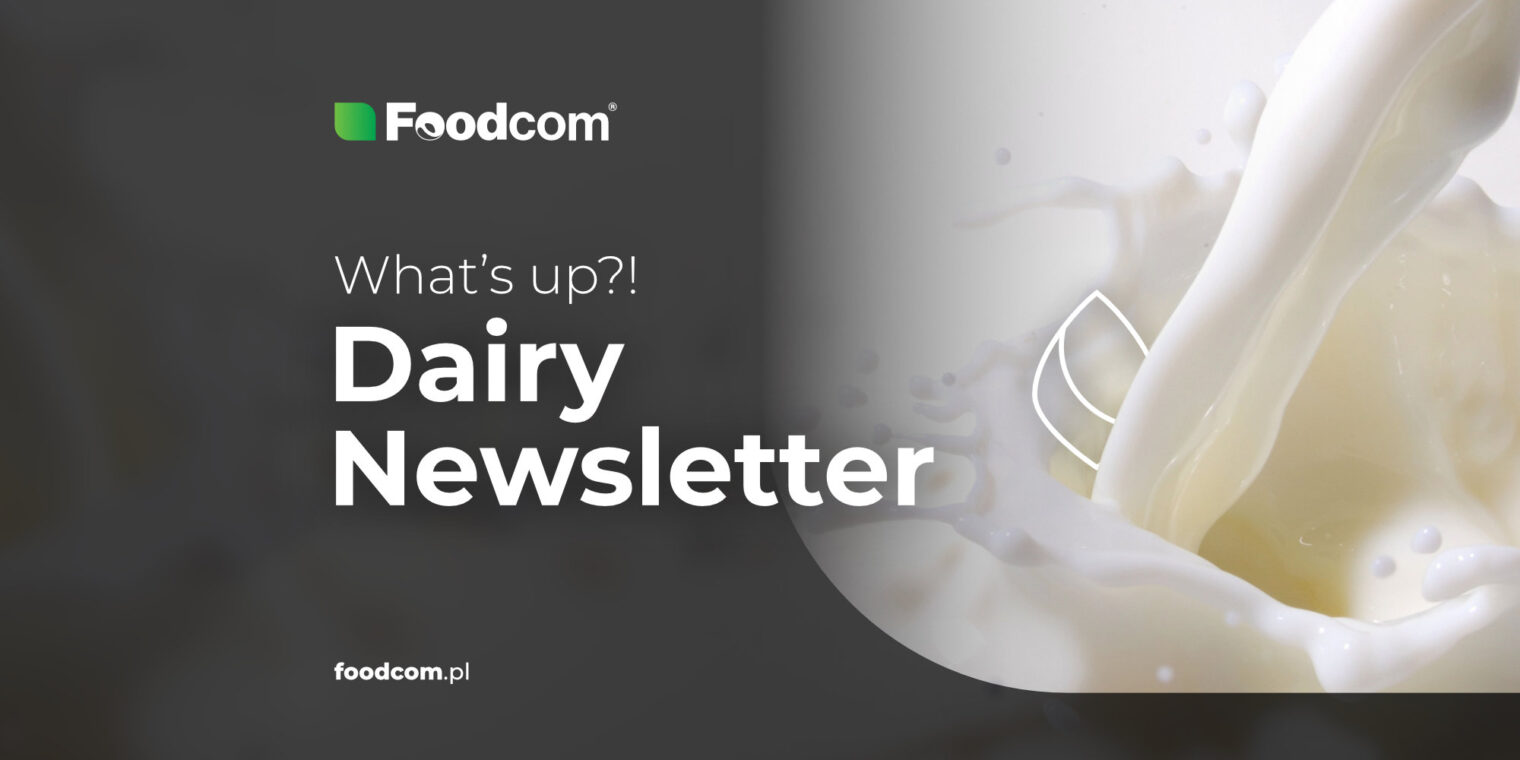‘I know that I know nothing,’ Socrates once said in his great wisdom. Or he did not, yet he is associated by many with this quote. In any case, these are also the words currently uttered by many observers of the dairy market when answering the question of what to expect in the second half of the year.
Although we have already passed the peak of milk production in Europe, the supply of the raw material itself and of dairy products remains high. At the same time, we are seeing an increase in prices and some movement in the dairy market. This is particularly evident in Cheese and Butter. For selected products such as Mozzarella and Cagliata, buyers are only beginning to accept higher prices after a longer period of time.
If we were to sum up the current situation in two words, they would probably be ‘movement’ and ‘uncertainty.’ These seem to be two entirely different things, but that’s the way it is with the dairy market. As always, more details on everything that matters can be found below.
Continue reading to learn about this week’s market insights.
With us, you’ll never miss a thing!
Butter
Recently, the illusion of higher Butter prices has become a reality, as Q1 2024 has been covered by buyers and therefore the selling price has reached 4.90 EUR/KG EXW. This has put a bit of pressure on buyers, signaling a trend of continuity in the fat sector following the Q4 2023 patch. This was not the only focus last week, as the valorization of the Anhydrous Milk Fat sector also reached an unexpected value of 6 on the front in some European regions.
Skimmed Milk Powder
Those who were satisfied with the selling price of Skimmed Milk Powder in their contracts under the Algerian government just 3 weeks ago are now talking about the price being undervalued and are looking for cheap raw material in the market to fulfill the contract in line with today’s product prices. In some regions of Europe, the price reaches 2.70 EUR/KG, while the other regions are not far from it. Growth sentiment does not seem to be deteriorating in the foreseeable future, but buyers are still reluctant to accept the reality of the current market trend.
Gouda/Edam
Last week we mentioned that Gouda and Edam are not in the market spotlight. However, this week we see them at the top of the cast. Especially with the hot trend in Cagliata and Mozzarella that sellers have been hoping for and lobbying to build. Given the upswing in the cheese sector, the question is whether retail pricing will pick up on this trend. We hope not. And many customers do as well.
Whey Protein Concentrate
The stocks that were built up were contracted at low, nice prices, so the producers began to increase the price gradually, which was acceptable to some. As a result, the price gradually built up and eventually increased quite significantly. On the other hand, the question arises whether customers are still as eager to buy at the current prices of over 5 EUR/ KG as they were at 4.5 EUR/KG. It should also be remembered that the biggest players have already signed the contracts until the end of the year, and the amount they will buy is insignificant and should not affect market prices at all.
Cream
Overall, it has been another week when both Cream and Skimmed Milk Concentrate have risen across Europe. We are past the peak of milk production and there is not as much raw material on the market as everyone expected. There is more demand for fresh products, so Cream is up.
Europe
Cheese production in European Union countries is growing at the expense of butter
According to the USDA’s latest EU dairy report, environmental regulations and high production costs are causing milk production to decline, even though cow yields are increasing. As a result, processors must make conscious decisions about what to use available milk for. As the consumption of cheese increases year after year and its price is more stable than other dairy products. Many processors choose to focus specifically on cheese, resulting in lower production of butter and milk powders. Wondering how long it will be before blocks of butter become more valuable than gold bars in Europe…
Milk is among the products for which a price cap is to be introduced in the UK
The British government is working on a program to introduce price caps on staples such as bread and milk in cooperation with supermarkets to combat the rising cost of living. This is in response to inflation, which has had a major impact on the cost of people’s shopping baskets. Participation in the program is to be voluntary, allowing supermarkets to decide for themselves which products the caps should apply to. The question is whether a program makes any sense at all in this situation, since the supermarkets will decide for themselves anyway…
Cows in Switzerland are doing better and better
According to the Swiss milk standard Der Grüner Teppich (The Green Carpet), 70% of the milk produced in Switzerland already meets the high sustainability requirements of the production standard. As a result, 90% of dairy milk and 33% of cheese milk are registered in the program and apply the sustainability standard. In addition, 91% of dairy farms meet the animal welfare requirements. Projections indicate that cow welfare will continue to increase through 2023. As they say, ‘Happy cow, delicious milk’ (they do not really say that, but maybe we just created a viral saying, who knows).
The Americas
Milk production in the U.S. increased slightly
In April, milk production in the United States was 8.7 billion kilograms, up 0.3% from a year earlier. Production per cow increased by half a kilogram year-on-year to 924 kilograms. The size of the dairy herd is also increasing, with the number of dairy cows on farms reaching 9.43 million head last month, up 26,000 cows from April 2022. Milk production increased in Idaho, Iowa, Indiana, Kansas, Michigan, Minnesota, Ohio, South Dakota, Texas and Wisconsin. The United States is holding on to its status as a land of milk and honey, there’s no doubt about it.
Mexican dairy production and imports will increase in 2023
The latest data show that we will see an increase in both dairy production and imports in the coming months. There are several reasons for this. The increase in imports will be driven primarily by a favorable exchange rate and increased domestic demand for dairy products, while higher milk production is likely due to favorable weather conditions and a growing herd. Higher production in Mexico itself is expected to translate into increased exports of cheese, butter and milk powder.
USDA launches new organic dairy promotion program
USDA recently announced the launch of the Organic Dairy Marketing Assistance Program, designed to mitigate the effects of market volatility, rising production and transportation costs, and unstable supply and feed prices that particularly affect the organic dairy industry. The program will be funded at $104 million. It will be made available to organic dairies to cover projected marketing costs in 2023, calculated based on 2022 costs.
Asia & Oceania
A popular milk brand in Australia has gone bankrupt
Made by Cow was a revolution in the dairy market when it was launched. It was the first company in Australia to offer cold-pressed raw milk, which as of 2016 was an alternative to hot pasteurized milk. Although the company (in its own words…) has gained thousands of loyal customers over the years, it had to declare bankruptcy a few days ago. Difficult economic conditions, including rising interest rates and inflation, and problems with supply chains were cited as reasons for the problems.
Significant increase in milk prices in India
India is one of the leading milk producers in the world. At the same time, Indians are the largest consumers of milk globally. For this reason, the increase in milk prices by about 15% in the last 15 months is particularly acute. Experts cite rising feed costs (as everywhere), increased demand for ice cream (as in many places), and contagious cattle diseases (definitely not as everywhere, and let’s hope it stays that way), among other reasons.
Negotiations on a trade agreement between Australia and the European Union are in full swing
One of the thorny issues is that the EU does not want Australian producers to use names like ‘feta’ to describe their products. Those involved themselves say that the introduction of such restrictions will have disastrous consequences, especially for small producers whose brands are not particularly well known in Europe for now. Producers are convinced that consumers are much more likely to reach for a product whose name they know. For this reason, Australian manufacturers are calling on the government to stand firm in negotiations, especially on this issue.







